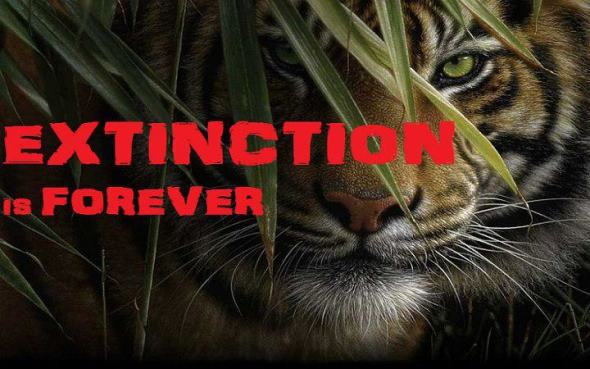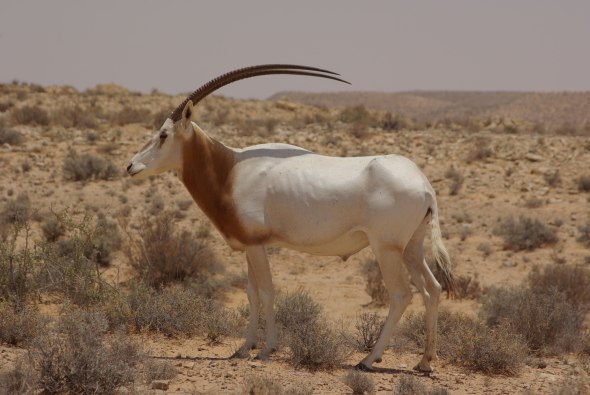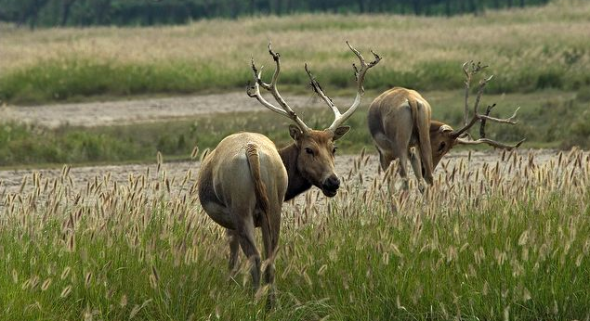Can hunting lead to Species Extinction?
Its a topic that we see spoken about within many animal rights and conservation debate forums, can hunting lead to species extinction? The answer is yes hunting can if not monitored lead directly to species extinction.
The many arguments that quote Cites can help stop species from extinction is not really valid. Cites - Convention on International Trade of Endangered Species does not cover the entire globe.
To date there are a total of one hundred and sixty member states (2013) that are bound by the Cites agreement. So in not so many words hunting can be (restricted) however this doesn’t mean that the member states have to agree with what Cites and other member states call for. Cites was established back in the early 1970’s of which has seen many species of animals and plants preserved. One must remember though that hunting is not the real threat to animals, humans are via over populating that leads to mass habitat fragmentation in many ways. Increased farming, urbanization and depletion of natural resources such as wood have had quite a profound affect to many species of plant and animal.
Case Study #1
Identified in 1826 by Cretzschmar - Oryx dammah.
(Extinct within the wild)..
O. dammah
The Oryx dammah is only extinct within the wild. However, 14,636 km away the Oryx dammah is not extinct on US ranches?, 14,636 km on a private farm in Texas these adorable mammals are trophy hunted. One would think that the farm would actually create a captive breeding program to reintroduce species of O. dammah back in the wild of Northern Africa.
Back in the 1960’s a global captive breeding program was launched when it was finally documented that hunters had literally over hunted the species into extinction. At the same time the African black and white Rhino was bordering extinction however won a reprieve, sadly even they are no longer safe bordering tipping point.
In 2005 a captive breeding assessment showed around some 1,500 individuals of O. dammah within captivity. From 2000-2007 the species was formally identified as completely extinct within the wild. In Chad and Niger it was estimated that a mere five hundred individuals were known to still be living within the wild from 1985. Scimitar horned oryx (common name) is regionally extinct within Algeria, Burkina Faso, Chad, Egypt, Libya, Mali, Mauritania, Morocco, Niger, Nigeria, Senegal, Sudan, Tunisia and the Western Sahara.
Hunters can agree or disagree. The evidence is clear today as it was back in the mid-1980’s when the species was formally assessed as (critically endangered).. Hunters are responsible for pushing species of mammal whether it be the Lion or the O. dammah into extinction. What really concerns International Animal Rescue Foundation’s conservation team is that environmental departments and enforcement agencies were fully aware many species of animals are threatened from human selfishness. Cites was not aware as the treaty was only drawn into practice back in the early 1970’s. Had the Convention on International Trade of Endangered Species that hosts some 160 member states been made aware of the plight of the O. dammah its quite possible they’d still be living within the wild.
Environmental departments on the African continent knew the O. dammah populations were being seriously depleted. So did international agencies. The O. dammah could have been taken into a secure captive breeding program way sooner than the 1960’s and/or protective secure parks established and manned to secure the species within the wild.
Over-hunting and habitat loss, including competition with domestic livestock, have been reported as the main reasons for the extinction of the wild population of Scimitar-horned oryx. Hunters still to this very day propagate unproven data stating the O. dammah is still pretty much alive within the wild. You’ll find that most of these hunters are either cattle ranchers that have never visited our Mama Africa or keyboard hunters that take facts from various sources outdated or unproven.
International Animal Rescue Foundation - Africa located seven ranches inside of the United States that allows tropical hunting of the O. dammah. One ranch we contacted we asked if they would be willing to ship out to Africa a dozen O. dammah for breeding yet we was informed the cattle were only hunted for trophies. Even with money talking not one ranch was willing to comply. (Please note we do not own a captive breeding facility)…
Cattle Ranches in Texas sell for hunting O. dammah Yearling Heifer/Bull priced at $800.00USD, cows as $1,100.00USD and bulls up to 36 inches at $1,300.00USD.. All included - to hunt sets you back a staggering $3,250.00.
Regardless of what hunters state there has been no definite evidence of the survival of this species in the wild for more than 15 years. Yet speak to a few Texan hunters and they’ll inform you otherwise. Sporadic reports of animals sighted in Niger and Chad have never been substantiated, despite extensive surveys dedicated to detection of Sahelo-Saharan antelopes carried out in Chad and Niger in 2001-2004.
It is sadly a fact that hunting whether it be trophy hunting or hunting for bush-meat has contributed to the extinction of this species within the wild. Any hunter that states no species of animal has ever been pushed to extinction within the past twenty years other than the Dodo and Tasmanian Tiger are bare faced uneducated liars that lack any form of conservationism education as their only type of conservation is keeping numbers down commonly known as “hunting” - Its hardly conserving any form of animal.
Case Study #2
Identified in 1866 by Milne and Edwards - Elaphurus davidianus
(Extinct within the wild)
E. davidianus
This species is listed as Extinct in the Wild, as all populations are still under captive management. The captive population in China has increased in recent years, and the possibility remains that free-ranging populations can be established some time in the near future. When that happens, its Red List status will need to be reassessed.
So here is that hunters (propaganda again) within many debates that we read within Animal Rights and conservation forums. The average hunter still argues that no animal has been pushed to extinction via hunting within the past two decades or less. Back in 1990 the Pere David’s Deer as it is commonly known was listed as (endangered). Cites that was well established back then knew this species of deer was facing extinction so did all member states as well as enforcement agencies and Department of Environments yet done nothing to preserve its status until now.
From 1994 the Pere David’s Deer was re-listed as endangered. From 1996 the species was listed again as (critically endangered). Sometime from 1980-1990 the species was re-listed as completely extinct within the wild of which prompted conservation agencies (only when we’d lost the species in the wild) to then begin a captive breeding program. Thankfully and after much success captive bred numbers have increased to over two thousand individuals. What was the main cause for their extinction within the wild?
The species became extinct in the wild due to habitat loss and hunting. The size of the reintroduced population was only 120 in 1993, although has increased to over 2,000 since that time. Low genetic diversity has been identified as a long-term threat by Zeng et al. (2007) and Yang et al. (2008). It is unclear how much native habitat remains on which E. davidianus can exist in a free-ranging state. Is it possible that the species can be reinstated to live freely within the wild? We believe so however to what extent they can remain (wild) within the (wild) is another story.
Would a reintroduction program of the Pere’s David Deer work though? I the Chief Environmental Officer Dr Josa Depre question this time again regarding many species of “horned” mammal that are currently threatened. So, we take a look at why the species E. davidianus was threatened? Firstly blaming US or any overseas hunters is not primarily to blame here. One only has to look at why the species was pushed into extinction to ascertain whether it is actually practical or even professional to reintroduce the species back into the wild of China from which it is endemic too.
Firstly I do not believe in the current climate of poaching and black market wildlife trade that reintroduction of the Pere’s David Deer is practical. E. davidianus was hunted mainly by Asian hunters legally and illegally. Hunted to extinction within the wild mainly for its fur, skeletons, meat, glands and derivatives. if one researches you’ll locate evidence of the Pere’s David Deer used in (TCM) commonly known as Traditional Chinese Medicine. This particular deer was hunted mostly for its glands and skeleton. Musk is wildly used within the far east as a Traditional Medicine and for the use of perfumes (internationally) that sell for hundreds of dollars. However and as shocking as this may read the Pere’s David Deer was hunted for its skeleton for the production of bone wines that is said to enhance sexual pleasure in both men and women.
However we cannot just lay blame here all on the Traditional Chinese Medicine trade. Hunters from all over the globe hunted the Pere’s David Deer mainly for its large and well formed antlers. Furthermore locals and Asians outside of China also hunted the deer for its meat known to be aromatic and tender.
Populations of the Pere’s David Deer are now increasing within (captivity).. Currently, there are a total of 53 herds of E. davidianus in China. Nine herds have fewer than 25 deer, 75.5% have fewer than 10 deer (Yang et al., 2003). Such a small herd size raise question about the effective population size and health of population genetics, since those herds are isolated and there is no gene exchange. The artificially dispersed E. davidianus herds are similar to a meta-population. The viability of the meta-population depends on the man-made gene exchange process by the managers.
Concerns via the International Union for the Conservation of Nature 2009:
A quarter of all antelope species are threatened with extinction.
The results, compiled by the Antelope Specialist Group of IUCN’s Species Survival Commission, show that out of 91 species of antelope, 25 are threatened with extinction. The status of several species has become worse since the last complete assessment of all antelopes in 1996.
“Unsustainable harvesting, whether for food or traditional medicine, and human encroachment on their habitat are the main threats facing antelopes,” says Dr Philippe Chardonnet, Co-Chair of the IUCN Antelope Specialist Group. “Most antelopes are found in developing countries which is why it’s critically important that we collaborate with local communities there since it is in their own interest to help preserve these animals.”
Five species of antelope are in the highest category of threat, Critically Endangered, including the Dama Gazelle (Nanger dama), Aders’ Duiker (Cephalophus adersi), the Saiga Antelope (Saiga tatarica), Hirola (Beatragus hunteri) and Addax (Addax nasomaculatus). The Scimitar Horned Oryx (Oryx dammah) is already Extinct in the Wild, but there are ongoing efforts to reintroduce it. The Dama Gazelle and Addax are both reduced to tiny remnant populations and highlight the dire situation for wildlife in the Sahelo-Saharan region.
A further nine species are in the next category of threat, Endangered, and another nine are classified as Vulnerable on the IUCN Red List of Threatened Species.
Nearly 70 percent of antelope species are not threatened with extinction and some areas of the world are doing better than others in terms of antelope populations. India, for example, is home to four species of antelope and only one of them is currently regarded as threatened.
“Despite the pressure of living alongside 1.2 billion people, antelopes are doing well in India,” says Dr David Mallon, Co-Chair of the IUCN Antelope Specialist Group. “It is no coincidence that there is very little tradition of hunting in India and gun ownership is rare.”
Overall, populations are stable in 31 percent of antelope species and decreasing in 62 percent of antelope species. The Springbok (Antidorcas marsupialis) a native of southern Africa is the only antelope species with a long-term increasing trend, mainly as a result of the game ranching industry.
Conclusion;
Today I have written this article for the many hundreds of Animal Rights Activists and Conservationists in training that are constantly put down by hunters for being “thick” knowing little about what they are actually debating about. Frankly I could go on and submit here another twelve species of mammal and several species of plants that have gone extinct within the wild caused primarily by human hunters and traffickers. Whether it be hunting for food, hunting illegally for the animal parts trade or trophy hunting the answer to the title Can hunting lead to species extinction even with Cites established is quite rightfully yes. My main beef here is that Cites and Governmental Environmental Agencies are fully aware of the many species of land and aquatic mammal that are facing extinction or seriously threatened within the wild. Yet have done little or nothing at all to conserve threatened species. Hunting does and has lead to many species of plant and animals going extinct. The Lion, Rhinoceros, Pangolin, Cheetah, many species of bird and Sharks even trees are all facing extinction within the wild and its hunters, poachers and traffickers that are all to blame. Whether hunting is legal or not without adequate and professional monitoring “any species of mammal or plant” can quite quickly vanish from under our noses.
While the two species above and some sixty nine species are formally extinct within the wild they are at the moment the very lucky ones. Conservation programs are at their very best helping to conserve the known sixty nine species of animal and plant. However there are a total of eight hundred and twenty eight recognized species of animal, fish and plants that are already extinct.
Extinction Means Forever..
If you would like you a fact a sheet on this article or wish to know more please contact myself or my Senior Environmental Officer at - [email protected].
Dr Josa C. Depre
Environmentalist and Botanical Scientist






